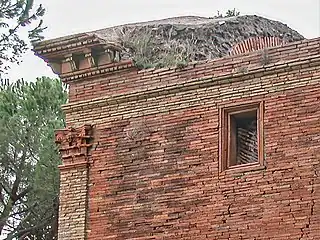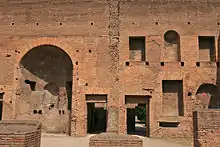Opus latericium
Opus latericium (Latin for "brick work") is an ancient Roman construction technique in which course-laid brickwork is used to face a core of opus caementicium.[1][2]

Example of opus latericium on a tomb of the ancient Appian Way in Rome.

A wall of the Domus Augustana in Rome
Opus reticulatum was the dominant form of wall construction in the Imperial era.[1] In the time of the architectural writer Vitruvius, opus latericium seems to have designated structures built using unfired mud bricks.[3]
See also
- Ancient Roman architecture – Ancient architectural style
- Opus mixtum, also known as opus compositum – Combination of Roman construction techniques
- Roman concrete – Building material used in ancient Rome
References
- Roth, Leland M. (1993). Understanding Architecture: Its Elements, History and Meaning (First ed.). Boulder, CO: Westview Press. pp. 222. ISBN 0-06-430158-3.
- Roger B. Ulrich; Caroline K. Quenemoen (10 October 2013). A Companion to Roman Architecture. John Wiley & Sons. pp. 493–. ISBN 978-1-118-32514-8.
- Vitruvius De Architectura 2.8 http://latin.packhum.org/loc/1056/1/0#26
This article is issued from Wikipedia. The text is licensed under Creative Commons - Attribution - Sharealike. Additional terms may apply for the media files.